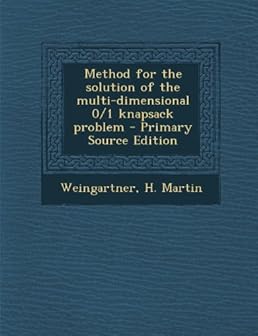A Dynamic Programming based solution for 0-Knapsack problem. A utility function that returns maximum of two integers. Returns the maximum value that can be put in a knapsack of capacity W. Developing a DP Algorithm for Knapsack.
Step 2: Recursively define the value of an optimal solution in terms of solutions to smaller problems.

I P`£V ¤TS Y ab for ¤c, illegal. The knapsack problem or rucksack problem is a problem in combinatorial optimization: Given a set of items, each with a weight and a value, determine the number of each item to include in a collection so that the total weight is less than or equal to a given limit and the total value is as large as possible. LusJS5-AGo Lignende 13.
Lastet opp av Tushar Roy – Coding Made Simple Given a bag which can only take certain weight W. Given list of items with their weights and price. Dynamic programming ( DP ) is a fancy name for using divide-and-conquer technique with a table. In this snippet, DP is used to solve the Knapsack Problem.

Overlapping subproblems: few subproblems in total, many recurring instances of each. The Knapsack problem can be reduced to the single-source shortest paths problem on a DAG (di- rected acyclic graph). This formulation can help build the intuition for the dynamic programming solution. The state associated with each vertex is similar to the dynamic programming formulation: vertex (i, j) . Given n objects and a knapsack” of capacity W. Item i has a weight w i. Also, this kind of function is ideal for doctests.
We now describe how to derive the optimal solution of this problem using dynamic program- ming. Solve the knapsack problem. As in our solution of the . Approach for Knapsack problem using Dynamic Programming. Although this problem can be solved using recursion and memoization but this post focuses on the dynamic programming solution. To learn, how to identify if a problem can be solved using dynamic programming , please . In this tutorial we will be learning about 0-Knapsack problem.
In this dynamic programming problem we have n items each with an associated weight and value (benefit or profit). The objective is to fill the knapsack with items such that we have a maximum profit without crossing the weight limit of the knapsack.

Given weights and values of n items, put these items in a knapsack of capacity M to get the maximum total value in the knapsack. Note that, you can select items, the sum of whose weight is less than or equal to the capacity of knapsack , W. The problem is to find a subset of items such that . But in integer knapsack problem , there is no such limit. This problem can be solved using bottom up DP.
We will first calculate the maximum attainable value in knapsack with duplicate items permitted with a capacity of 1. Then, we will tabulate this value and use this value to calculate the . This scales significantly better to larger numbers of items, which lets us solve very large optimization problems such as resource allocation. Then every time we call the recursion we first check the table to see if the solution was . EXAMPLE: SOLVING KNAPSACK PROBLEM WITH DYNAMIC PROGRAMMING. Selection of n=items, capacity of knapsack M=8.
However, this chapter will cover 0-Knapsack problem and its analysis. In 0-Knapsack, items cannot be broken which means the thief . Note: One can imagine a version of the problem called the fractional- knapsack problem in which we can take 2. Does the counter-example above still work? Greedy solution for knapsack of size 50. Yes, with an algorithm based on dynamic programming.
Optimal substructure: How.